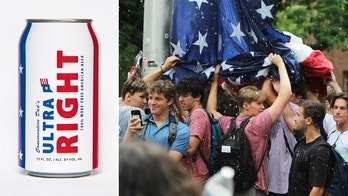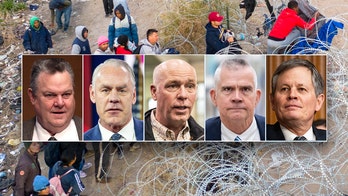Immigration reform battle pits Democrats against White House
Critics call detainment of families inhumane
This is the sixth in a series of posts, one year after the surge of unaccompanied undocumented minors who crossed across the U.S.-Mexico border, examining the effects it has had on communities, schools and children themselves.
Inside Berks County Family Residential Center in Pennsylvania, the movies “Wall-E” and “How To Train Your Dragon” echoed in the hallways recently as children sat raptly in a handful of makeshift classrooms.
It was the last day of school for 44 undocumented children who have called Berks their home for weeks, months and, for some, for over a year.
Down the hall, staff members boast about the activities offered to its “residents.” Parents play bingo. Some take part in a Zumba class, others watch Telemundo. One mother blared Tejano music while playfully chasing her children in one of the communal rooms that house six undocumented immigrants at a time.
A year after drastically expanding the use of immigrant family detention centers, the Obama administration is fighting to keep them open in the face of mounting criticism characterizing the detention of parents and their children as un-American and inhumane.
Before last summer, there was only one shelter and 96 beds nationwide that were dedicated to housing undocumented families. Today, there are more than 3,000 beds nationwide in three family detention centers that are designed to hold mainly mothers and their young children for months at a time as they await their immigration court hearings.
More than 2,100 undocumented immigrants are currently being held at these centers, primarily in two new centers in Dilley and Karnes in Southern Texas. Running at full capacity, the centers that serve as temporary shelters could cost the federal government $345 million a year.
The Obama administration argues that family detention centers are worth keeping — they are necessary, officials say, to handle last year’s overwhelming surge of 68,000 unaccompanied children who illegally crossed the border in addition to another 68,000 more “family units” who entered the United States from Central America.
But immigrant advocates contend these “residential facilities” are nothing less than jails — subjecting children and mothers to more psychological trauma. Many of those in the shelters fled extreme poverty and gang violence in Central America. Advocates insist that these families should be released to relatives in the United States while they await their court dates, as was done before last year’s surge.
“Anywhere that you would have to stay for more than a year where you have no ability to control your own life, your own schedule, your own child and you are not free to leave – that is a prison,” said Bridget Cambria, a practicing immigration lawyer whose firm is currently representing between 10 to 15 families.
In the last two weeks, 136 House Democrats and 33 Senate Democrats have penned letters demanding that families be released from the centers while they await their immigration hearings. The letters cited complaints of physical abuse, medical neglect, and psychological harm on children and mothers who have already been victims of gang or domestic violence, kidnapping, and sex trafficking.
The Department of Justice, however, has argued that detaining parents and their children guarantees that they will show up to their immigration court date and not flee. According to the Executive Office of Immigration Review, up to 40 percent of released undocumented immigrants in 2014 failed to show up to court.
The DOJ insists the centers have served as a deterrent, ending the perception among Central American families that the U.S. government was giving out “permisos,” or permits, that allowed them to stay freely. The centers, some argue, have contributed to the 47 percent drop in the number of families illegally crossing the border during the same time last year.
Department of Homeland Security Secretary Jeh Johnson defended family detention centers this week, insisting they are effective and humane because they keep families together. The lesser alternative, he argues, would be to separate families – keeping parents detained while releasing children to relatives or to the Department of Health and Human Services.
“I personally visited several of them to ensure myself that the conditions of confinement are appropriate,” Johnson said during a congressional oversight hearing in April. “I believe that our expanded detention capability in the face of last year's situation was the right thing to do and I believe that it had an influence on our overall efforts.”
In April, however, U.S. District Judge Dolly Gee in California sided against the administration, tentatively ruling that detaining children is “inappropriate” and unlawful in the face of a 1997 settlement on child migration, according to a memo obtained by Fox News Latino. The judge found it “astonishing” that the government invested money into building centers without more evidence supporting the fact that it would deter illegal immigration.
“This belief that establishing these facilities will deter migration, it won't,” Cambria, the lawyer, told Fox News Latino, “because that is not the reason they are coming. They are going to come regardless of whether they are put in these facilities. They are coming to save their lives.”
If immigration lawyers and the Obama administration do not reach a settlement by June 19, the judge could issue a final order overhauling family detention as we know it, experts say.
While the Obama administration has steadfastly defended the centers, Immigration and Customs Enforcement has not taken sides.
In May, ICE Director Sarah R. Saldaña announced enhanced oversight and accountability while reviewing cases for any families detained for more than 90 days.
“We understand the unique and sensitive nature of detaining families,” Saldaña said, “and we are committed to maintaining the optimal level of care.”
The administration, however, continues to move forward with expanding family detention centers. An additional 700 beds will be added by the end of the year, doubling the size of Berks and Karnes.
Easy entry – Horrific stay
“Coming to the United States was very easy,” Gladys Dubón, 21, who spent 11 months at Berks, told Fox News Latino.
Dubón, one of Cambria’s clients, fled Honduras with her 2-year-old daughter, Katarina, and arrived at Berks May 19th, 2014.
The young mother left Honduras after MS-18 gang kidnapped her daughter and held her for ransom. She paid $5,000 to secure her release, and then left because of continued threats on her life. Scared, Dubón paid a coyote $3,000 to travel through Honduras, Guatemala and Mexico. She eventually surrendered to Immigration and Customs Enforcement authorities at the Rio Grande border before being transferred to Berks.
During her 11-month stay, Dubón said, her daughter got sick. Katarina threw up blood for three straight days. She claims Berks did not give her proper care, with doctors telling her more water and sleep would cure her ills.
“It wasn't until she vomited blood for the fourth time that they took her to the hospital,” Dubón said about the April incident.
Berks officials say they were not aware about the child’s condition and immediately took action once medical staff was contacted.
“Medical care at the center is extremely comprehensive and available to the residents 24 hours a day,” officials at the center said. ”Any accusations of inadequate care are looked into immediately by the state and ICE, and if found credible, appropriate actions are taken.”
Operated by the Berks County, the facility currently houses 86 undocumented immigrants. Once held for weeks at a time, Berks officials acknowledge that now families are spending months at the center.
Inside, families freely walk around the facility. Officials tout access to legal counsel and mental health experts. A fridge stacked with milk and fruit is readily available and a cafeteria serves a daily menu, which on a recent way included chicken pot pie and macaroni salad. A U.S. Public Health medical staff is on-call 24 hours a day.
But Dubon said it’s a depressing atmosphere. She says even though there are comfortable areas for children, “the kids cry that they want to get out of there. Many kids stop eating because sometimes the food is bad.” She says staff members often force families to wake up at 6 a.m. by slamming doors and turning on bright lights.
“Some of those who work there have a hatred toward immigrants, treat immigrants badly and with contempt,” she said. “It's really sad.”
In January, a Berks guard, Daniel W. Sharkey, 40, was charged for sexually assaulting a 19-year-old Honduran woman, who was housed in the facility. Berks officials say they immediately put Sharkey on leave and began a four-month investigation by ICE internal affairs and Bern Township police.
At the 500-bed facility in Karnes Texas, operated by a for-profit prison company, a 19-year-old immigrant mother recently attempted suicide. Lilian Olivia Bardales survived after slashing her wrist last week in the bathroom. She has since been deported, but not before she penned a two-page suicide letter describing her eight-month stay at Karnes as “killing me little by little.” “Treated worse than an animal,” she lamented in the letter. “That’s why I do this because you were bad to me.”
ICE officials say Bardales was treated for a “surface-level abrasion” and that the injury was “minor and in no way life-threatening.” They say Bardales was distraught that she had lost her court case, and she had telephonic access to her legal counsel available to her.
The agency said it is doing the best it can – considering how many people flooded the shelters at once last year.
“Family residential centers are an important part of the U.S. government’s comprehensive response to the unprecedented spike in illegal migration that occurred last summer,” an ICE statement said. “Family residential centers are an effective and humane alternative for maintaining family unity as families go through immigration proceedings or await return to their home countries.”
READ PART 1: Tens of thousands of immigrant children remain in limbo
READ PART 2: As crisis overwhelms system, philanthropy steps in
READ PART 3: Courts backlogged until 2019 to accommodate minors
READ PART 4: New U.S. policies have led to less children crossing
READ PART 5: The perilous corridor to the U.S. slowly clearing out





